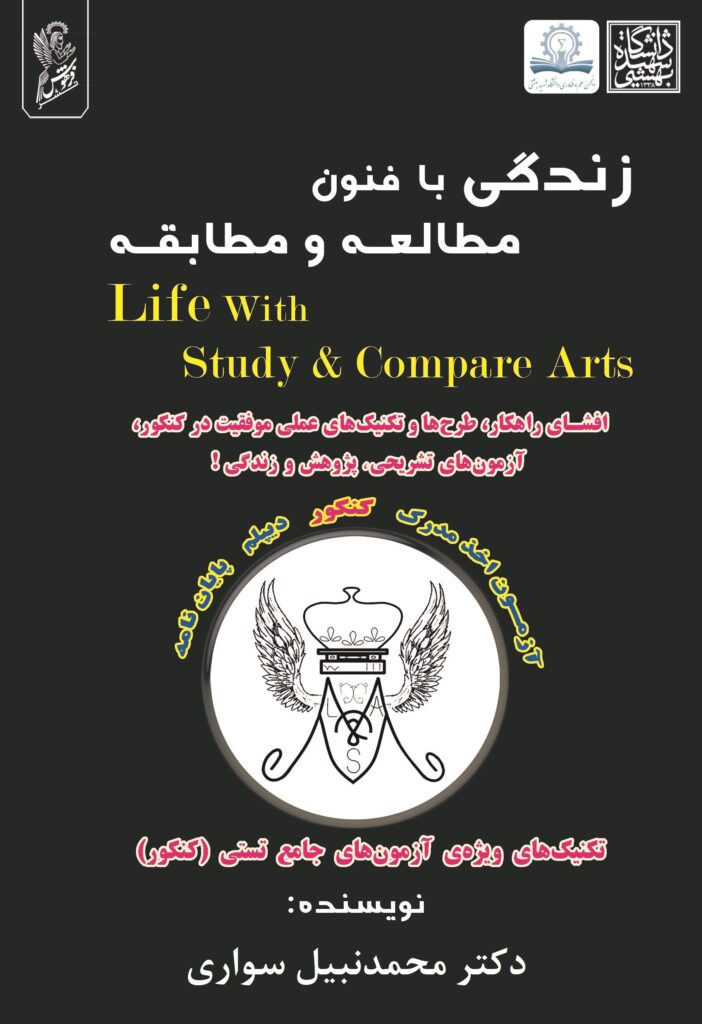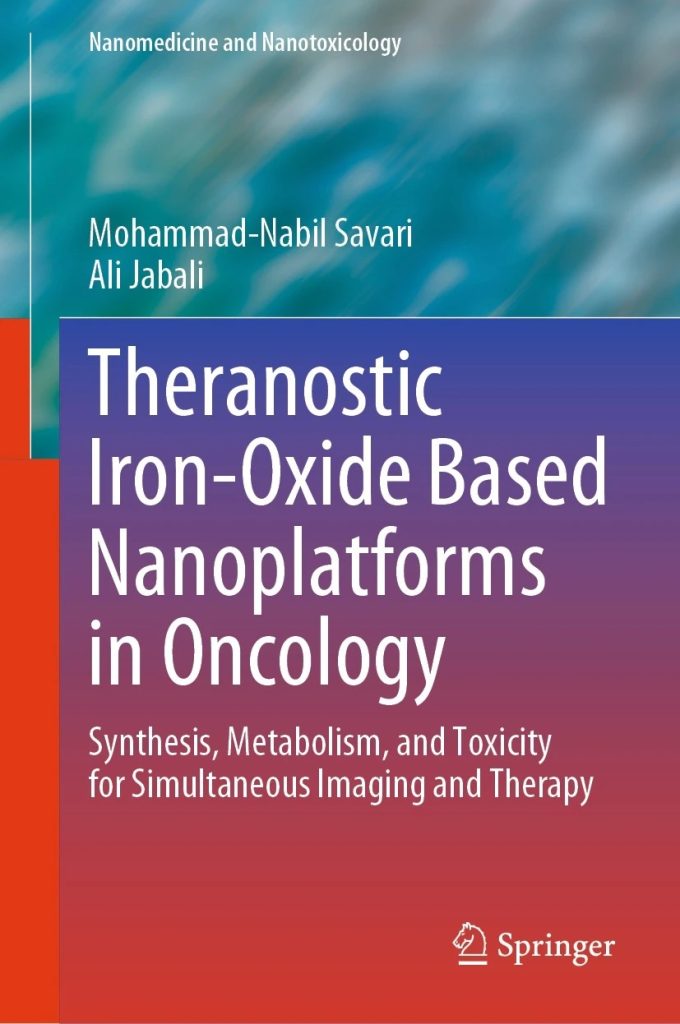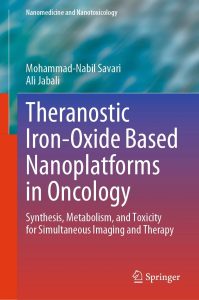کنکور
فصل 1 – مقدمه
1.1 – انگیزش
1.2 – خلاصهای از نظريهی یادگیری (خبرپردازي)
1.3 – سرنام و شرح راه کار طرح ها و تکنیک های کتاب
فصل 2 – راه کار مطالعاتی و مطابقاتی
2.1 – M1: PCDTS- قرنطینهی اولویتی فکری و محیطی
فصل 3 – طرحهای مطالعاتی و مطابقتی
3.1 – D1 :EQARL2CT- مطالعات و مطابقات برای اخذ مدرک
D2 :POQCERL2AT – 3.2- مطالعات و مطابقت آزاد
D3 :P2SENPPR – 3.3- مطالعات و مطابقت آزاد
D4:RSIE – 3.4- مطالعه و مطابقه برای زندگی
فصل 4 – تکینکهای مطالعه و مطابقه
T 1:TLPCOT – 4.1- تکنیک درس محور و جامع سازماندهی شدهی هدفمند
T 2:TPLST – 4.2- تکنیک جدول زمانبندی صفحه درس محور
فصل 5 – دیگر روشهای مطالعه و یادگیری ثبت جهانی (ضمیمه)
5.1 – روش مطالعه پارتیزانی (PrePeR)
5.2 -روش مطالعه پسختام (SQ3R)
5.3 – روش مطالعه PQRST
5.4 – روش مطالعه مردر(Murder)
فصل 6 – سخن آخر

برای رزرو وقت مشاوره با نویسنده این کتاب از اطلاعات تماس بالای صفحه استفاده کنید
نانوپزشکی

1 Introduction
References
2 Drug Conjugation Chemistry in Iron Oxide Nanoparticles (IONPs)
2.1 Covalent Drug-Conjugated Iron Oxide Nanoparticles
2.1.1 Amide Linkage Drug Conjugation
2.1.2 Drug Conjugation with pH-Sensitive Bonding
2.1.3 Drug Conjugation with Enzymatically Responsive Bonding
2.1.4 Oxidation/Reduction Drug Conjugation
2.2 Non-Covalent Drug-Conjugated Iron Oxide Nanoparticles (IONPs)
2.2.1 Hydrophobic Drug Conjugation
2.2.2 Drug Conjugation Using Electrostatics
2.2.3 Drug Conjugation with Encapsulation
References
3 Superparamagnetic Iron Oxide Nanoparticle (SPION) Synthesis
3.1 Physical Methods
3.1.1 Deposition in the Gas Phase
3.1.2 Lithography Using Electronic Beam
3.1.3 Laser Ablation with Pulses
3.1.4 Pyrolysis Caused by a Laser
3.1.5 Strong Ball Milling
3.1.6 Combustion
3.2 Chemical Methods
3.2.1 Chemical Coprecipitation Synthesis
3.2.2 Thermolysis (Thermal Decomposition)
3.2.3 Microemulsions
3.2.4 Synthesis Using Hydrothermal Method
3.3 Biological Approach
References
4 Properties of Iron Oxide Nanoparticles (IONPs)
4.1 Structural Properties
4.1.1 Colloidal Stability
4.1.2 Shape and Size
4.1.3 Charge of Surface
4.2 Magnetic Properties
4.3 Thermal Properties
4.4 Optical Properties
4.4.1 Fluorescence Techniques and Encapsulated IONPs
References
5 Pharmacokinetics of IONPs
5.1 Absorption/Uptake
5.1.1 Size and Coating Material’s Impact on Absorption
5.1.2 Charge’s Impact on Uptake and Absorption
5.1.3 Uptake of IONPs in the Brain
5.2 Distribution
5.2.1 Iron and IONP Physicochemical Properties Affecting the Distribution
5.3 Metabolism
5.4 Affecting the Cell Physiology
5.4.1 Influence on Cell Proliferation
5.4.2 Effect on Stem Cell Differentiation
5.4.3 Affects Cell Migration
5.5 Excretion
5.6 Regulation of Iron in Human
5.6.1 Human Body’s Iron Flow
5.6.2 The Liver Is the Main Organ for Iron Homeostasis
5.6.3 Iron Regulation
5.6.4 Macrophages Are in Charge of Iron Homeostasis
5.6.5 Monocytes and the Iron Metabolism Process
5.6.6 Iron-Related Infection and Immunity
References
6 Magnetic Nanoparticles in Stimuli-Responsive Drug Delivery Systems
6.1 Drug Delivery Systems with Stimuli-Responsiveness Through Ligand-Mediated MNPs
6.1.1 Organic Ligands
6.1.2 Inorganic Ligands
6.1.3 Hybrid Inorganic-Organic Ligands
6.2 The Most Common Methods for Synthesizing MNP-Based Drug Delivery Systems
6.2.1 Thin Films Hydration
6.2.2 Evaporation Emulsion
6.2.3 Solvent Exchange
References
7 IONPs-Based Treatment Methods
7.1 Chemotherapy
7.2 Stimuli-Responsive Delivery Nanoplatforms
7.2.1 Endogenous Stimuli-Responsive Nanoplatforms
7.2.2 Nanoplatforms That Deliver in Response to Exogenous Stimuli
7.2.3 Delivery Platform with Dual-Stimuli
7.3 Nanoplatforms with Receptor-Targeted IONPs
7.3.1 Passive Targeting
7.3.2 Active Targeting
7.4 Biologically Based Treatment Plan
7.5 Photodynamic Therapy (PDT)
7.5.1 Current Restrictions on the Use of Photodynamic Therapy in Cancer
7.6 Photothermal Therapy
7.7 Magnetic Hyperthermia
7.7.1 Magnetic Hyperthermia Principles and Clinical Application
7.7.2 Magnetic Hyperthermia and MRI
7.7.3 Effect of Particle Structure, Composition, and Aggregation on Magnetic Properties
7.7.4 Multicomponent IONPs for Heating and Imaging
7.8 Sonodynamic Therapy (SDT)
7.9 Radiotherapy
7.9.1 Radiotherapy and Real-Time Monitoring of Oxygen Delivery Nano-platforms
7.10 Immunotherapy
7.11 Gene Delivery
References
8 Diagnosis
8.1 Magnetic Resonance Imaging (MRI)
8.1.1 Important Factors Improving the T2 Relaxivities of IONPs
8.1.2 T1 CA with IONP
8.1.3 Dual-Modal IONP-Based Imaging
8.1.4 Responsive MRI CAs Based on IONP
8.1.5 IONP Behavior Optimization in Vivo
8.1.6 Greater Biocompatibility
8.2 Imaging Using Computed Tomography (CT)
8.3 Imaging with Ultrasound
8.4 Radionuclides for SPECT and PET Imaging Diagnostics
8.4.1 PET or Positron Emission Tomography
8.4.2 SPECT, or Single-Photon Emission Computed Tomography
References
9 Biosensing
9.1 Devices for Optical Biosensing
9.1.1 Devices for Colorimetric Biosensing
9.1.2 Devices for Fluorescent Biosensing
9.1.3 Devices for Surface Plasmon Resonance Biosensing
9.1.4 Devices for Surface-Enhanced Raman Scattering Biosensing
9.2 Devices for Electrochemical Biosensing
9.2.1 Devices for Potentiometric Biosensing
9.2.2 Devices for Conductometric Biosensing
9.2.3 Devices for Amperometric Biosensing
9.2.4 Devices for Impedimetric Biosensing
References
10 Bioassays Based on Magnetic Phenomena
10.1 Bioassay Based on GMR
10.2 Bioassay Based on MTJ
10.3 Bioassay Based on MPS
10.4 Bioassay Based on NMR
References
11 Cytotoxicity/Toxicity
11.1 Oxidative Stress
11.2 Special Size/Shape Toxicity
11.3 Accumulation at a Specific Site
11.4 Results of Pulmonary Exposure
11.4.1 Mechanisms
11.4.2 Animal Studies
11.4.3 Genotoxicity
11.5 Human Studies
References
12 Coatings
12.1 Dextran
12.2 PEG or Poly(Ethylene)glycol
12.3 Silica
12.4 PVA or Polyvinyl Alcohol 12.5 Lipids
12.6 Additional Coatings
References
13 Concluding Remarks and Future Perspectives
نویسنده آماده مشارکت در نوشتن، تامین بودجه و چاپ کتاب، مقاله، پایان نامه و… شما در بهترین انتشارات بین المللی است. اطلاعات تماس در بالای صفحه
Full Text: 410 Pages and 1749 References
تدریس (صوتی)
1- مفهوم بزرگسالی و آموزش بزرگسالان
2- نظریه یادگیری بزرگسالان: آندراگوژی
3- نظریههای تدریس در آموزش بزرگسالان
4- درک و تسهیل یادگیری بزرگسالان
5- درک فراگیران بزرگسال
6- بررسی جهت گیری فلسفی معلم بزرگسالان
7- تشخیص سبک تدریس
8- طراحی آموزشی
9- درک و به کارگیری سبکهای یادگیری
10- ایجاد محیطهای برانگیزاننده یادگیری
11- رهنمودهایی برای انتخاب روشها و فنون تدریس
12- داستان موردی
13- تلوزیون تعاملی
14- تکنیکهای یادگیری از راه دور
15- قراردادهای یادگیری
16- پوشه تحصیلی دروس
17- فروم، پانل و سمپوزیوم
18- ارتقاء اجتماعات یادگیری در فضای مجازی
19- هدایت گری

Theranostic Iron-Oxide Based Nanoplatforms in Oncology

References
URL: https://link.springer.com/book/10.1007/978-981-99-6507-6
نویسنده: Mohammad-Nabil Savari
نام: Theranostic Iron-Oxide Based Nanoplatforms in Oncology: Synthesis, Metabolism, and Toxicity for Simultaneous Imaging and Therapy
Url: https://link.springer.com/book/10.1007/978-981-99-6507-6
نویسنده: Mohammad-Nabil Savari
ISBN: 978-981-99-6506-9
تاریخ انتشار: 2023-10-25
فرمت: https://schema.org/EBook
5